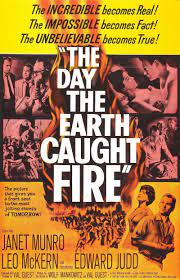
One man walks through the sweltering, deserted streets of London. His name is Peter Stenning (Edward Judd), a former journalist with the Daily Express, but he has fallen on hard times after a divorce and too much booze. His editor Jeff Jefferson (Arthur Christiansen) isn’t giving him the plum assignments anymore. His only friend, Bill Maguire (the wonderful Leo McKern) , helps him occasionally.
The Soviet Union and the United States recently detonated nuclear bomb tests, triggering strange meteorological events. Stenning is sent to the British Meteorological Office for temperature data and meets Jeannie Craig (Janet Munro), a young telephonist, and they hit it off. He discovers that Earth’s axis of rotation has changed by 11 degrees, affecting the climate zones. Water evaporates on a grand scale and Britain is shrouded in mist. The changing schedule of solar eclipses reveals that the Earth is spiralling in toward the sun.
The government imposes a state of emergency and rations water. There are riots and the cities are being emptied. Scientists want to detonate more bombs in Western Siberia to fix the problem. Stenning. Maguire, and Jeannie gather in a bar and listen to the radio. The bombs go off and dust falls from the ceiling. The newspaper has printed two versions of the front page—“World Saved” and “World Doomed”—and we do not learn which one they will use.
The movie was written by Wolf Mankowitz and directed by Val Guest and is a tense, moody classic of the apocalyptic sub-genre. Matte paintings of abandoned cities and desolate landscapes abound. The breakdown of social order is starkly pictured. Arthur Christiansen was in fact the real Editor of the Daily Express. No-one wanted to make this film and Val Guest had to put up his own money to do it. It is in black and white except for orange scenes depicting the sweltering heat. The joyous church bells at the end were added by Universal Studios to create an uplifting ending. It won the Bafta Award for screenplay.A policeman in the street was played by Michael Caine.
The Roneo Duplication Company threatened to sue the producers for showing one of their stencil duplicators breaking down. I wonder where the stencil company is now. I worked for the Hartford Times in Connecticut in the Sixties, and the newspaper in the film is exactly the way it was. The production was allowed to shoot inside the Ministry of Defence Building in Whitehall. Some shots from the Quatermass Xperiment (also by Val Guest) were used. Richard Burton and Peter Finch declined to play the hard-drinking hero. Monty Norman, who wrote music for the film, wrote the music for Doctor No a year later. In the age of vaccination protests, it is amusing to see rioters protesting water-rationing by throwing water around.
